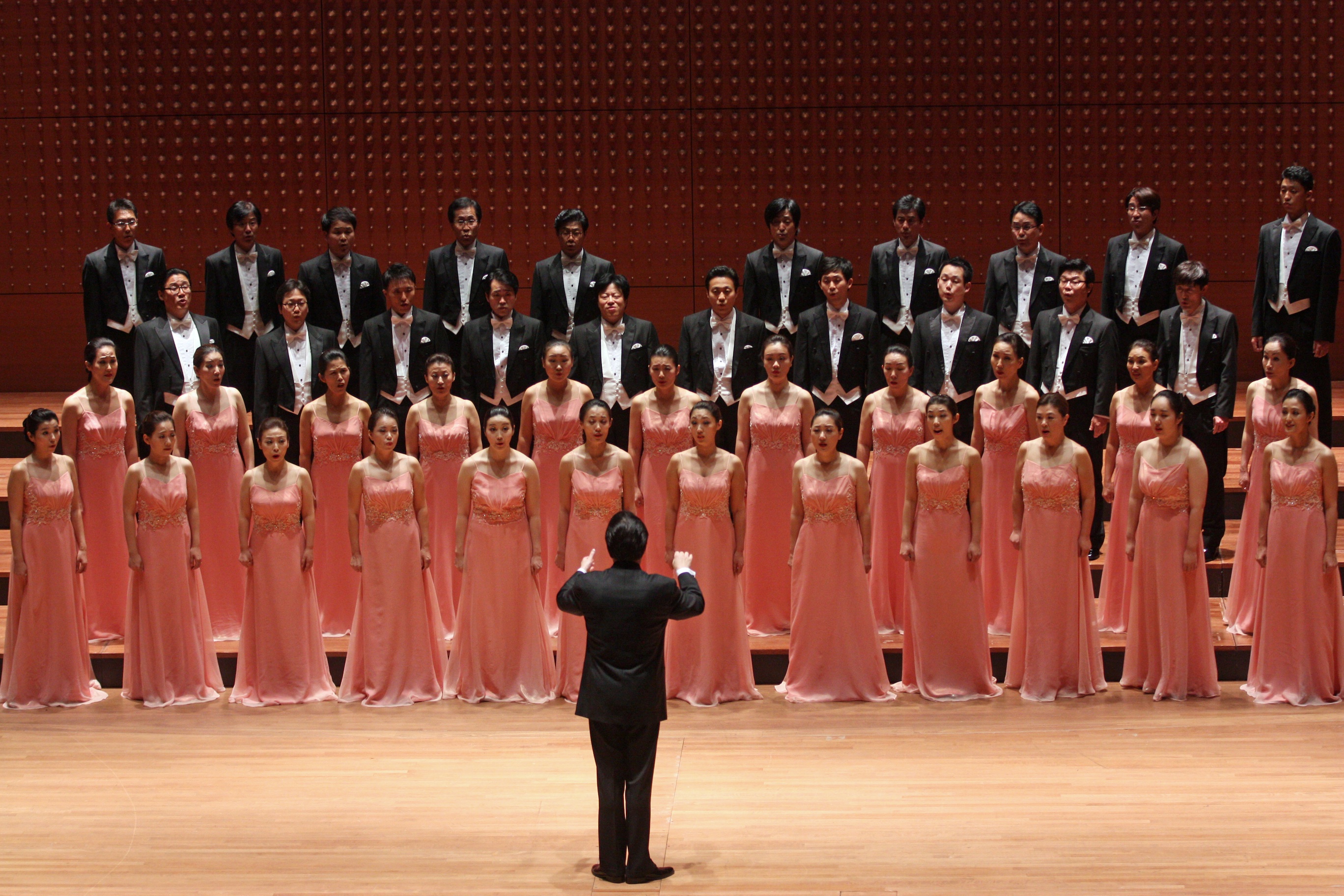Now in its 30th year, The Suwon Civic Chorale from South Korea was invited by Distinguished Concerts International New York (DCINY) to perform at Alice Tully Hall. In a program featuring traditional Korean music, modern Korean music (including two commissioned works written especially for this occasion and given their World Premieres), and American favorites, it had all the makings of an interesting and educational evening.
The Suwon Civic Chorale filed on stage in traditional Korean dress. Before starting the concert proper, conductor Dr. In-Gi Min requested that the audience stand as the Chorale sang the national anthems of South Korea and the United States – a thoughtful and respectful gesture that I very much appreciated.
The first half was dedicated to the music of Korea. Arirang is to Koreans what Finlandia is to the Finnish, a much-loved, unofficial national anthem. Composer Sung-Hyun Yoon used the traditional theme with modern Western compositional technique, a musical East meets West that was given a heartfelt performance and approval from the appreciative audience. Following this setting, Jung-Sun Park’s Kyrie from the Arirang Mass was expertly performed, reflecting traditional Korean harmony and an ornamented singing technique that would be difficult for those without training in Korean singing tradition. As throughout the entire concert, Dr. Min led in an attentive and restrained manner with no showboating – the music was always first and foremost. When a work was finished, Dr. Min would retire stage left and gesture to the Chorale before taking any bows of his own, demonstrating a humility I would like to see more conductors emulate.
Four traditional songs, the Stephen Foster-like Gagopa (Wishing to Return), the three-note based Saeya, Saeya (Blue Bird), the charming Sae Taryung (The Bird Song), with the four soloists singing bird calls in antiphonal style, and the work song Mokdosori (A Song of Pole Carrying), which was sung with gusto, all served as a introduction to the folk music of Korea. The joy of the Chorale members sharing their traditional melodies was apparent, both from the visual and aural aspects of the performances.
The two commissioned works were by highly accomplished Korean composers. The Dona nobis pacem by Keeyoung Kim (b. 1963) is complex, with extensive chromaticism, Korean pentatonic modes, and using a circle of thirds, instead of the traditional western circle of fifths. The Chorale gave this demanding and intricate work a praiseworthy performance. Miserere by Jeeyoung Kim (b. 1968) is a powerful work, from the quiet opening with Tibetan bowls to create what is considered the sound of Heaven in Korea, to the two solos sung in a traditional style called Jeong-Ga, to the bold middle and ending sections. The Chorale realized all of Ms. Kim’s musical ideas in what must be called a simply dazzling performance. Both composers were in attendance, and took richly deserved bows.
The Chorale returned to the stage after intermission with the women dressed in evening gowns and the men in tuxedos with tails. The second half opened with two works by the highly popular American composer Eric Whitacre, Lux Aurumque and Little Birds.
Lux Aurumque is one of Whitacre’s best-known and most frequently performed works. Anyone who is familiar with the YouTube sensation Whitacre’s Virtual Choir has seen and heard this work. The Chorale mastered the tight harmonies with precision, often with the SATB parts dividing into two, and the sopranos even into three. The balance, as the title suggests, was “golden”. Little Birds uses verses written by the Mexican poet Octavio Paz. The composer suggested in his performance instructions that the singers research real bird calls and whistles, and it seemed from the sensitive performance that his instructions were heeded. There was a feel that the sounds of the birds flowed organically and did not ever overshadow the vocals. The effect was enchanting in a nuanced way.
After the Whitacre works, it was time for something completely different, and that was the entertaining Kecak Attack. This work is based on the Indonesian monkey dance of the same name. The chorus separated into smaller sub-sections and used the sound cak-ka-cak in rhythms of various complexities, with snapping fingers and choreographed gestures in an attack-counterattack manner between the divided forces. The sense of play brought much laughter; even Dr. Min got into the act by an exaggerated “push back” of the ever-bolder faction of tenors moving forward in a mock menacing fashion. The incongruity of this spectacle and the elegantly attired performers added to the hilarity.
After this “play”, it was time to get back to serious work with Samuel Barber’s Agnus Dei, an a cappella arrangement of his masterpiece, the Adagio for Strings. The arrangement retains all the beauty of the original as well as the challenges of voicing and intonation. Both must be precise throughout, or else the entire effect is destroyed – there simply is no margin for error. Using an interesting repositioning of the singers (male-female alternating in all rows), the Chorale met the challenges and delivered a very moving performance. If I had one reservation, it was that the tempo was a bit too fast for my taste, but this was a personal preference. To end, two traditional Americana songs, Shenandoah and The Battle of Jericho were given solid readings. The full house responded with a prolonged ovation and was rewarded with three encores, the highlight of which was a nod to the Big Apple by way of the highly stylish New York, New York, complete with ballroom dancing and Rockette-style kicks. It was a huge hit.

